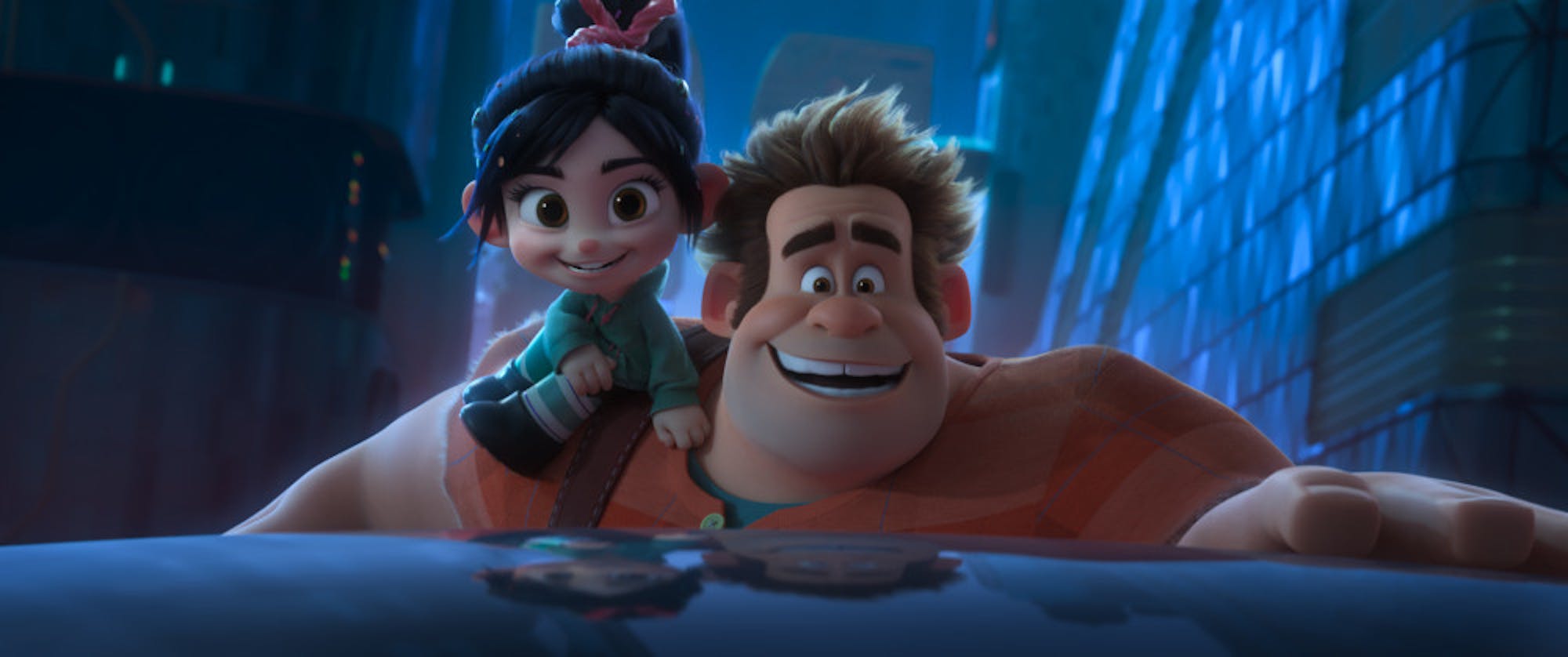
Courtesy of Walt Disney Pictures
The “Wreck-It Ralph” franchise returned after six years to deliver a story as heartwarming as its first. With its depictions of social media, online shopping and gratuitous “Fortnite” references, “Ralph Breaks the Internet” is unmistakably set in 2018. The story balances the modern web and ‘80s origins — between young and older audiences, between cliches and fresh plotlines — to create a heartfelt and fun film.
The story itself also resumes six years after the first movie. Ralph (John C. Reilly) and Vanellope von Schweetz (Sarah Silverman) enjoy a night out, jumping between arcade machines — joyrides in “Tron,” root beer in “Tapper” — just as they have, every night, for years. They watch the sun rise in Game Central Station, the transport hub between games, Ralph perfectly content with his unchanging routine. When he looks to Vanellope to affirm their happiness, she balks, admitting that she’s growing bored of her home game, “Sugar Rush.” She’s exhausted with racing the same tracks against the same characters, day in and day out. Ralph’s attempt to remedy her boredom breaks “Sugar Rush”’s machine; Ralph and Vanellope are eager to jump into the internet to find the needed replacement parts. A misunderstanding of Ebay lands them $27,001 in debt, and the two are thrown into a quest to make the money before the 24-hour hold on their item expires.
Like its predecessor, the movie thrives on its setting. As vast as the world of the arcade games was, it is dwarfed by the scale of the internet, which awes Ralph and Vanellope (and the viewer) in a spectacular pan-over of a metropolis of information. Amazon’s building pierces the skyline. Twitter’s birds roost and tweet on massive trees. Humanized pop-up ads spawn in front of netizens. The movie introduces its first online gaming platform with an open-world game called “Slaughter Race,” where the movie shifts into a high-speed action film. “Ralph Breaks the Internet” is worth seeing for the car chase between Vanellope and an armed gang alone. Vanellope is later led into Disney’s kingdom, where the movie makes no small amount of jokes about its own cliches and storytelling conventions, as well as its marketing schemes. This in no way detracts from the nostalgia of hearing Disney princess’ theme songs used in the soundtrack.
Though Ralph remains the true protagonist, Vanellope’s arc is no less satisfying, and often more engaging than Ralph’s. The film cuts between Vanellope and Ralph’s perspectives, shifting between radically different sides of the internet. Vanellope, the princess of “Sugar Rush,” seeks a true Disney-style revelation about her own aspirations, complete with a musical number. Ralph speeds between online crazes, giving viewers a whirlwind tour of the last ten years of social media — though the mentions were not always on-beat; the film contained too many references to the internet’s fondness for cat videos. Though the film focuses far more on the two main characters than the first did, its secondary cast, though likeable, is not nearly as fleshed out — none are as memorable as Fix-It Felix Jr. (Jack McBrayer) or Calhoun (Jane Lynch).
“Ralph Breaks the Internet” feels like the organic, inevitable conclusion to the first movie. Both Ralph and Vanellope’s personalities have evolved significantly, befitting the change in their situations since the first movie. Ralph has become more childish and lost his bitter independence. Vanellope is more thoughtful, moving away from her single-minded focus in the first movie. “Wreck-It Ralph” was a movie about personal identity, and the sequel is largely a coming of age. The two must, once again, face who they are and who they want to be, with and without one another, with and without their games. It’s a more intimate challenge — unlike before, the protagonists have something they fear losing. The severity of their insecurity gradually mounts, driving the plot and visual direction of the film toward darker and darker tones. The movie’s genre fluidity especially shines, straying into a thriller genre. The film allows its characters to make mistakes; ultimately, forgiveness — both of self and others — plays a critical role within the movie.
The plot isn’t perfect. For it to function, we need ignore two small, but major, inconsistencies. Vanellope’s glitch is not presented consistently, and Ralph does not return to his game during Litwak’s opening hours, an act that threatened to shut down his game in the previous movie. Still, the character arcs, worldbuilding and the overwhelming heart are more than enough to drive the film. Ralph and Vanellope’s journey into the internet is important to them, and those stakes hold throughout the entire film. The film breaks out all the usual Disney wit and humor, but creates a story where compromise is necessary and dreams are not always easy to understand. If nothing else, come for the nostalgia, stay for the humor and be sure to stick around after the credits.





